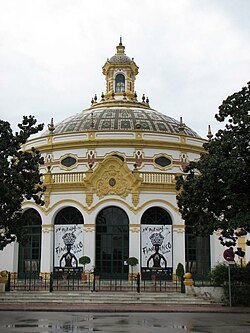 Exhibition Casino, theatre to the left Exhibition Casino, theatre to the left | |
 | |
| Address | Seville |
|---|---|
| Coordinates | 37°22′44″N 5°59′27″W / 37.378823°N 5.990792°W / 37.378823; -5.990792 |
| Opened | 1929 |
| Website | |
| www.teatrolopedevega.org/ | |
The Lope de Vega Theatre (Spanish: Teatro Lope de Vega) is a small Baroque Revival theatre that was built for the Ibero-American Exposition of 1929 in Seville, Spain, in the same building as the Exhibition Casino. It stands on the Avenida Maria Luisa street near the Maria Luisa Park just north of the Pavilion of Peru. The theater is named after the famous 16th-century Spanish playwright Lope de Vega. After the exposition the theatre had a mixed history. It suffered damage from fire and flood. At times it was closed and at times was partially restored and reopened. The building has been used as a hospital and as a trade show venue. Following its most recent renovation the theatre has become one of Seville's most important centres for cultural events.
Construction
The Pabellón de Sevilla (Pavilion of Seville) housing the theatre and casino was designed by the young architect Vicente Traver y Tomás.
He chose a Baroque style that reflected Levantine influences. Elements of Baroque architecture were used in the physical structure as well as in the ornamentation. The theatre hall was fronted by the exhibition casino, which is roofed by a dome decorated in ceramics. The hall was laid out according to the canons of Italian opera, with two wings and 1,025 seats, and was one of the most modern theaters in Spain in its day. The decor by Martínez del Cid y Zaragoza was dominated by red, with fine details in gold and ivory decorating the roof and railings, and with the door and furniture painted green.
Construction of the 4,600 square metres (50,000 sq ft) theatre took just two years and included installation of an automatic electric generator which often failed, interrupting the performances. The cost was 1.2 million pesetas, a huge amount at the time. The theater was inaugurated on 30 March 1929 with a comedy by Martinez Serra entitled The Blind Heart (El Corazón Ciego). During the exhibition the building was illuminated, like other buildings of the exhibition, with powerful external spotlights that enhanced the attractive appearance of the hall.
Later history

After the exhibition, the theatre had ups and downs, competing with cinemas and football. It was closed for a while, then re-opened as the Municipal Theatre Lope de Vega in 1936. The event was celebrated with a dance orchestra in the terrace beside the casino. The new opening did not last long. During the Civil War (1936–1939) the casino became a hospital, with the walls freshly painted white. A fire in the theater destroyed the central chandelier and all the seats. Also, the Guadalquivir river overflowed to flood the pit.
After the return of peace, in October 1939 the city council decided to organise a season of opera. They cleaned the theatre, repaired the roof and installed indirect lighting. The theatre came back into use for opera and operetta, and was also used by amateur theatre groups and even schools. In 1961, renewed flooding again caused damage to the pit, and fresh renovations were required. In 1977 the theatre was assigned to the Ministry of Culture, and after a facelift became the National Theatre of Lope de Vega Sevilla. The theatre was used for a trade show in 1985. The World Chess Championship was held at the theater in 1987.
Recent years
The theatre was returned to the city of Seville in 1985, and over a two-year period the architect Victor Perez Escolano made significant alterations, returning the theatre to its original design, although this limited the number of spectators to 749. The first performance after the reopening in February 1988 was a concert by the London Philharmonic Orchestra. From then on, the theatre has put on more than 180 performances every year to over 100,000 spectators. The theatre today stages classical and modern plays and concerts, and flamenco shows. It is a venue for the Flamenco Biennale of Seville, which is held on even-numbered years, and is among the most important theatres in Spain. As of January 2009 further repairs were needed, especially to the casino dome which had tiles missing and was leaking.
Gallery
-
One entrance of the pavillon, the entrance leads through the Casino of the building
-
North facade of the building
-
Lope de Vega Theatre
References
- "Teatro Lope de Vega Sevilla". Sevilla5. 15 January 2006. Retrieved 2011-11-09.
- ^ Fiona Flores Watson. "TEATRO LOPE DE VEGA". Andalucia.com. Retrieved 2011-11-10.
- "See Exact Location". infosevilla. 15 July 2019. Retrieved 2019-07-15.
- "Teatro Lope de Vega de Sevilla". See Map (in Spanish). Retrieved 2011-11-12.
- ^ "El Teatro de a Exposición y Casino". Sevilla Siglo XX. 30 January 2009. Retrieved 2011-11-11.
- "History of monument: Lope de Vega theatre". A. Valparaiso Ocio y Cultura S.L. Retrieved 2011-11-10.
- ^ "Historia del Teatro Lope de Vega" (in Spanish). Teatro Lope de Vega. Archived from the original on 2011-10-26. Retrieved 2011-11-09.
- "Teatro Lope de Vega" (in Spanish). Bienal de Flamenco - Ayto. de Sevilla. Retrieved 2011-11-12.
| Ibero-American Exposition of 1929 | |
|---|---|
| |
| Pavilions | |
| Attractions | |
| Urban development | |
| |